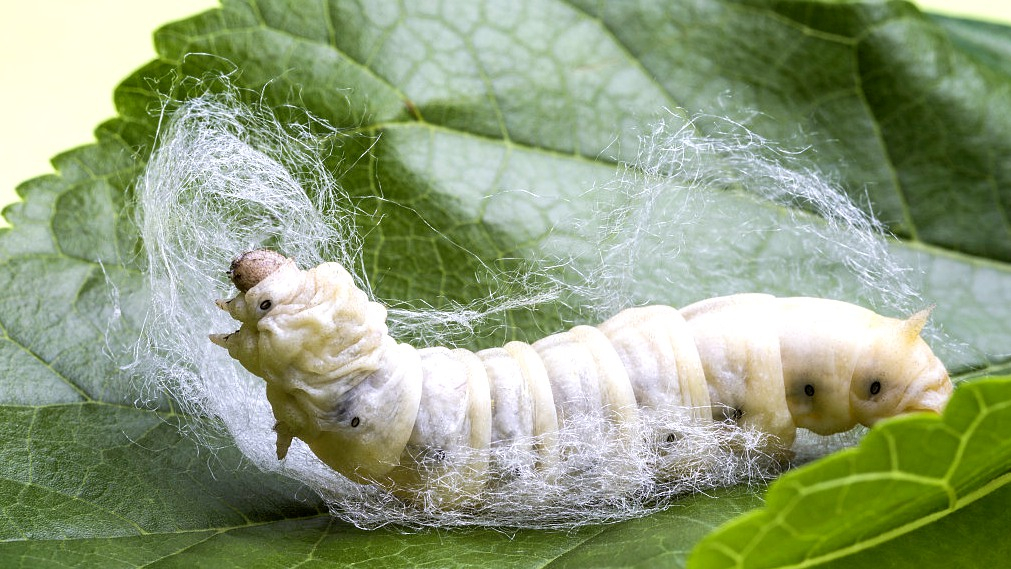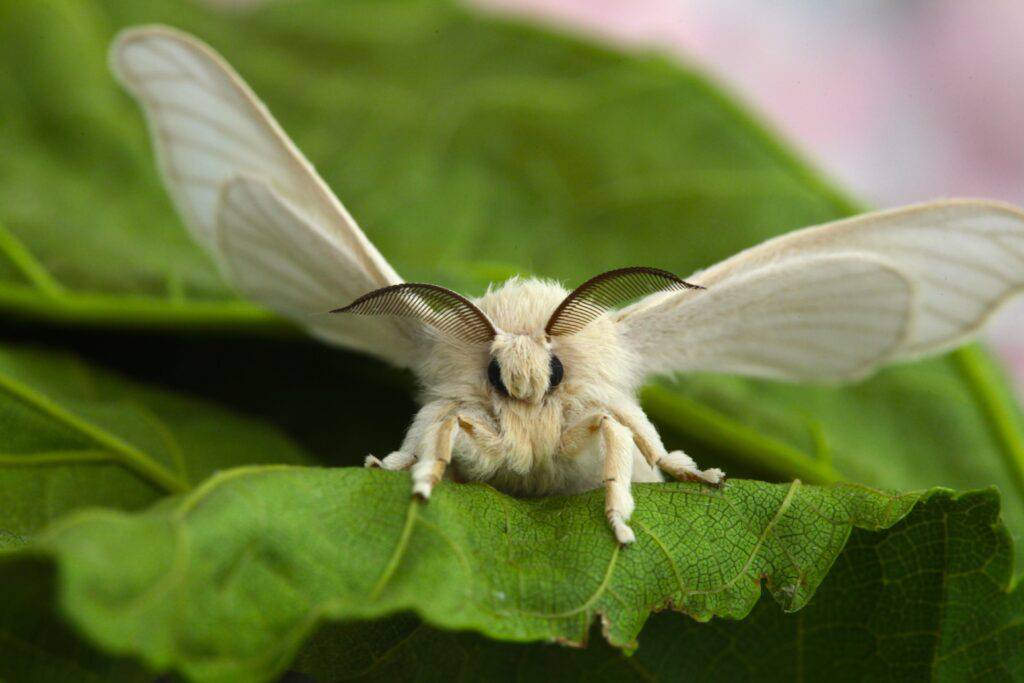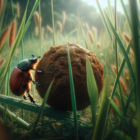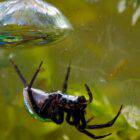How do silkworms produce silk?

The intricate process of silk production begins with a tiny, unassuming creature: the silkworm. The life cycle of the silkworm, Bombyx mori, is a journey encompassing four distinct stages that showcase the intricacies of nature’s design.
Silkworm Life Cycle
The life cycle of the silkworm begins with the laying of eggs by the female silk moth, typically on the leaves of the mulberry tree. The eggs, resembling tiny, pin-sized spheres, contain the genetic blueprint for the silkworm’s entire life cycle.
Upon the completion of an incubation period lasting about a week, the eggs hatch into larvae, marking the commencement of the silkworm’s feeding stage. These voracious caterpillars, armed with powerful mandibles, immediately turn their attention to the succulent and nutritious leaves of the mulberry tree.
As the silkworms feast on the mulberry leaves, they undergo a series of molting stages, shedding their exoskeletons to accommodate their rapidly expanding bodies. Over a span of four to six weeks, the larvae experience several molts, transforming from tiny, fragile creatures into plump and resilient caterpillars.
The feeding stage is not merely about sustenance; it is a critical period of preparation for the subsequent phases of the silkworm’s life. The nutrients acquired from the mulberry leaves fuel the development of silk glands, specialized structures located in the silkworm’s head. These silk glands play a pivotal role in the silk production process, as they are responsible for secreting the liquid silk that will eventually solidify into the cocoon.
As the feeding stage reaches its culmination, the silkworms enter a preparatory phase known as the wandering stage. During this time, the silkworms cease eating and begin to search for an appropriate location to spin their protective cocoons. This instinctual behavior is a prelude to the transformative pupal stage, where the silkworm undergoes metamorphosis within the confines of its silk sanctuary.
Mulberry Leaves and Feeding
Mulberry trees, belonging to the Moraceae family, provide an ideal environment for silkworm cultivation. The leaves of these trees serve as a nutritional powerhouse for the voracious appetites of the silkworm larvae.
The process begins when a female silk moth carefully selects a suitable mulberry tree to lay her eggs. This careful selection is not arbitrary; it ensures that the emerging larvae will have immediate access to the nourishing mulberry leaves essential for their survival.
The silkworm’s affinity for mulberry leaves is not only a matter of preference but a biological necessity. These leaves are rich in nutrients, including proteins, carbohydrates, vitamins, and minerals, which are indispensable for the rapid growth that characterizes the larval stage.
As the silkworms hatch from their eggs, they embark on a feeding frenzy, consuming prodigious amounts of mulberry leaves to fuel their metamorphic journey.
The silkworms exhibit a fascinating behavior known as “silk chewing” during feeding. Instead of directly ingesting the leaves, they chew them into small fragments, facilitating the extraction of nutrients. The mulberry leaves undergo a transformation within the silkworm’s digestive system, where enzymes break down complex compounds into simpler forms that can be assimilated for growth and energy.
Silk Glands and Silk Production
Silk production is a unique attribute of silkworms, and it begins with the specialized glands located in their heads. At the heart of silk production are two types of glands: the silk gland and the sericin gland.
The silk gland is the primary source of fibroin, a protein-rich liquid that solidifies into silk threads. As the silkworm progresses through its larval stage, these glands undergo remarkable development, attaining their peak activity during the cocoon-spinning phase.
Silk glands are divided into two sections: the posterior silk gland and the middle silk gland. The posterior silk gland synthesizes the core fibroin proteins, while the middle silk gland contributes enzymes and additional fibrous proteins. The intricate coordination between these glands results in the secretion of a semi-liquid substance containing fibroin and sericin. This substance, often compared to a liquid crystalline solution, holds the key to the creation of silk threads.
As the silkworm approaches the cocoon-spinning stage, it displays a remarkable behavioral shift. It begins to produce silk by exuding the liquid silk through small openings called spinnerets, strategically located near its mouth. The spinnerets, resembling microscopic tubes, extrude the liquid silk in controlled quantities, allowing the silkworm to navigate the intricate process of cocoon spinning with precision.
The liquid silk, initially in a gel-like state, undergoes a rapid transformation upon exposure to the air. This process, known as solidification or coagulation, is triggered by the change in environmental conditions and results in the formation of silk threads. The coagulation process is essential for the silk to retain its strength and flexibility, characteristics that define the quality of the final silk product.
Cocoon Spinning and Structure
The cocoon spinning process is an intricate dance, a choreography dictated by the silkworm’s rhythmic head movements. In a mesmerizing figure-eight pattern, the silkworm strategically weaves the silk threads, creating a delicate yet resilient structure around itself. The meticulous nature of this process is a marvel, considering that a single silk cocoon can contain a continuous strand of silk measuring up to 900 meters in length.
The structure of the silk cocoon serves multiple functions. Its primary purpose is to provide a secure haven for the silkworm during its pupal stage, shielding it from potential predators and environmental stressors. The outer layer of the cocoon is composed of sericin, a gum-like substance that hardens upon exposure to air. This outer layer acts as a protective shield, forming a durable barrier against external threats.
Beneath the outer layer lies the inner structure of the cocoon, consisting of tightly woven silk threads. These threads create a fine, yet strong, lattice that cradles the pupa within. The arrangement of the threads is such that they form a network of spirals and layers, maximizing the structural integrity of the cocoon. This intricate design not only provides physical protection but also aids in regulating the internal environment of the cocoon, maintaining optimal conditions for the silkworm’s metamorphosis.
The cocoon spinning process unfolds rapidly, typically taking the silkworm just a few days to complete this architectural marvel. The resulting structure, though seemingly delicate, boasts an astonishing strength that belies its fragile appearance.

Metamorphosis and Adult Moth Emergence
Within the confines of its silk cocoon, the silkworm undergoes a profound transformation. It pupates and metamorphoses into an adult silk moth. During this stage, it secretes enzymes that soften the sericin, enabling the moth to emerge from the cocoon. This emergence, symbolic of rebirth and renewal, marks the completion of the silkworm’s life cycle.
Harvesting Silk and Sericulture
Silk production is intertwined with sericulture, the art and science of cultivating silkworms. The culmination of this intricate process involves carefully harvesting the silk threads from the cocoon. Skilled artisans, often referred to as sericulturists, employ techniques that preserve the length and quality of the silk fibers. This meticulous process transforms raw silk into the lustrous and sought-after material that has adorned royalty and graced runways throughout history.
The journey of silk production is a testament to the marvels of nature and the ingenuity of human craftsmanship. From the humble silkworm to the intricate weaving of silk threads, each stage of the process contributes to the creation of a textile that transcends time and culture. The story of silk production is not just a biological marvel but a rich tapestry woven with threads of history, culture, and the delicate beauty of nature.










